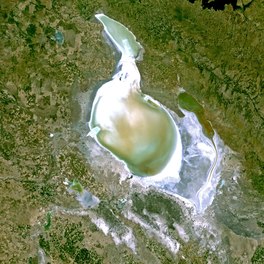| Lake Tuz | |
|---|---|
 View from space | |
| Location | Central Anatolia |
| Coordinates | 38°44′N 33°23′E / 38.733°N 33.383°E |
| Type | endorheic hypersaline |
| Primary inflows | Peçenek Çayı, Melendiz Çayı |
| Primary outflows | none |
| Catchment area | 11,900 km2 (4,600 sq mi) |
| Basin countries | Turkey |
| Max. length | 80 km (50 mi) |
| Max. width | 50 km (31 mi) |
| Surface area | 1,600 km2 (620 sq mi) |
| Average depth | 0.5 m (2 ft) |
| Max. depth | 1.5 m (5 ft) |
| Surface elevation | 905 m (2,969 ft) |
| Settlements | Şereflikoçhisar, Eskil |
Lake Tuz (Turkish: Tuz Gölü meaning 'Salt Lake) is the second largest lake in Turkey with its 1,665 km2 (643 sq mi) surface area and one of the largest hypersaline lakes in the world. It is located in the Central Anatolia Region, 105 km (65 mi) northeast of Konya, 150 km (93 mi) south-southeast of Ankara and 57 km (35 mi) northwest of Aksaray. In recent years, Lake Tuz has become a hotspot for tourists. In October 2021, Lake Tuz temporarily dried up completely due to water mismanagement and climate change.[1][2]
- ^ Guzel, Mehmet; Fraser, Suzan (28 October 2021). "Turkey's Lake Tuz dries up due to climate change, farming". AP News.
- ^ Kathryn Hansen: Disappearing Lake Tuz: Large Lake Is Now Just a Puddle. SciTechDaily, 16 December 2021. Source: NASA Earth Observatory.
